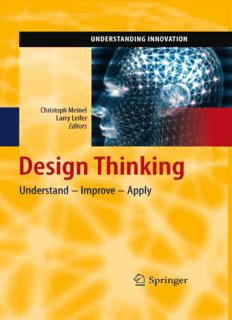Table Of ContentUnderstanding Innovation
SeriesEditors
ChristophMeinel
LarryLeifer
Forothertitlespublishedinthisseries,goto
http://www.springer.com/series/8802
Hasso Plattner • Christoph Meinel • Larry Leifer
Editors
Design Thinking
Understand – Improve – Apply
ABC
Editors
HassoPlattner ChristophMeinel
Hasso-Plattner-Institutfu¨r Hasso-Plattner-Institutfu¨r
SoftwaresystemtechnikGmbH SoftwaresystemtechnikGmbH
Prof.-Dr.-Helmert-Str.2-3 Prof.-Dr.-Helmert-Str.2-3
14482Potsdam 14482Potsdam
Germany Germany
[email protected] [email protected]
LarryLeifer
CenterforDesignResearch(CDR)
StanfordUniversity
424PanamaMall
Stanford,CA94305-2232
USA
[email protected]
ISBN978-3-642-13756-3 e-ISBN978-3-642-13757-0
DOI10.1007/978-3-642-13757-0
SpringerHeidelbergDordrechtLondonNewYork
(cid:2)c Springer-VerlagBerlinHeidelberg2011
Thisworkissubjecttocopyright.Allrightsarereserved,whetherthewholeorpartofthematerialis
concerned,specificallytherightsoftranslation,reprinting,reuseofillustrations,recitation,broadcasting,
reproductiononmicrofilmorinanyotherway,andstorageindatabanks.Duplicationofthispublication
orpartsthereofispermittedonlyundertheprovisionsoftheGermanCopyrightLawofSeptember9,
1965,initscurrentversion,andpermissionforusemustalwaysbeobtainedfromSpringer.Violations
areliabletoprosecutionundertheGermanCopyrightLaw.
Theuseofgeneral descriptive names,registered names,trademarks, etc. inthis publication does not
imply,evenintheabsenceofaspecificstatement,thatsuchnamesareexemptfromtherelevantprotective
lawsandregulationsandthereforefreeforgeneraluse.
Coverdesign:WMXDesignGmbH
Printedonacid-freepaper
SpringerispartofSpringerScience+BusinessMedia(www.springer.com)
Foreword
In2005,theHasso-Plattner-InstituteofDesignatStanfordUniversityinCalifornia
begantoteachDesignThinkingtoengineeringstudents.Thephilosophybehindthis
venturewastheconvictionthatitispossibletotrainengineersandscientiststobe-
comeinnovators.DesignThinkinghassincebecomeahighlyrecommendedcourse
intheStanfordengineeringcurriculum.ThemethodofDesignThinkingmeldsan
end-userfocuswithmultidisciplinarycollaborationanditerativeimprovementand
is a powerful tool for achieving desirable, user-friendly, and economically viable
designsolutionsandinnovativeproductsandservices.In2007,asecondSchoolof
Design Thinking,operatingunder similar premises, was established at the Hasso-
Plattner-Institute (HPI) for IT Systems Engineering in Potsdam, Germany. It has
been equally successful in attracting students and external partners from indus-
try, the public sector, and society,and producinginnovativeproductsand services
solutions.
My motivation behind initiating the HPI-Stanford Design Thinking Research
Program was the desire to understandwhy and how the Design Thinking method
works on a scientific basis. Through joint research projects, we try to figure out
which factorsultimately contribute to the success of this type of innovationin all
areasoflife.Inordertoimplementinnovationprocessesinindustryandthepublic
sector,wemuststrivetoimproveourunderstandingofthem.
My main interestis to see the Design Thinkingmethod used in IT/engineering
andtounderstandhowitinspirescreativemultidisciplinaryteamworkacrossfacul-
ties;whetherandhowspatial,time,andculturalboundariescanbeovercome;and
how it can be meshed with traditional approachesin the field of engineering. We
mightalsobeabletoproposedifferentorganizationalstructuresfordesignteamsin
corporations.
Ithasalsobeenamysterytomeforalongtimewhythestructureofsuccessful
designteamsdifferssosubstantiallyfromtraditionalcorporatestructures.
I am delighted and proud to see this transatlantic research cooperation thrive
and develop into a potent academic force in the field of innovation research, and
I am confident that answers to some of these questions can be found – and to an
v
vi Foreword
extent – have already been found. This volume presents the first comprehensive
collectionoftheresearchstudiescarriedoutbytheHPI-StanfordDesignThinking
ResearchProgramandisanexcellentstartingpointforthenewSpringerserieson
“UnderstandingInnovation.”
Potsdam/PaloAlto HassoPlattner
May2010
Contents
DesignThinkingResearch ....................................................... xiii
ChristophMeinelandLarryLeifer
PartI DesignThinking inVariousContexts
DesignThinking:AFruitfulConceptforITDevelopment? ................. 3
TilmannLindberg,ChristophMeinel,andRalfWagner
AUnifiedInnovationProcessModelforEngineeringDesigners
andManagers ..................................................................... 19
PhilippSkogstadandLarryLeifer
ProductDifferentiationbyAestheticandCreativeDesign:
APsychologicalandNeuralFrameworkofDesignThinking................ 45
MartinReimannandOliverSchilke
PartII Understanding DesignThinking
Re-representation: Affordances of Shared Models
inTeam-BasedDesign ............................................................ 61
JonathanEdelmanandRebeccaCurrano
The Co-evolution of Theory and Practice in Design
Thinking–or–“MindtheOddnessTrap!”.................................... 81
JuliavonThienen,ChristineNoweski,ChristophMeinel,
andIngoRauth
InnovationandCulture:ExploringtheWorkofDesigners
AcrosstheGlobe .................................................................. 101
PamelaHindsandJoachimLyon
TheEfficacyofPrototypingUnderTimeConstraints ........................ 111
StevenP.DowandScottR.Klemmer
vii
viii Contents
PartIII ToolsforDesignThinking
AnInstrument forReal-TimeDesignInteractionCapture
andAnalysis ....................................................................... 131
MatthiasUflacker,ThomasKowark,andAlexanderZeier
Tele-Board:EnablingEfficientCollaborationInDigitalDesign
SpacesAcrossTimeandDistance............................................... 147
RajaGumienny,ChristophMeinel,LutzGericke,
MatthiasQuasthoff,PeterLoBue,andChristianWillems
PhysicalityinDistributedDesignCollaboration
HowEmbodimentandGestureCanRe-establishRapportand
SupportBetterDesign............................................................... 165
DavidSirkin
PartIV DesignThinking inInformationTechnology
BringingDesignThinkingtoBusinessProcessModeling .................... 181
AlexanderLuebbeandMathiasWeske
Agile Software Development in Virtual Collaboration
Environments...................................................................... 197
RobertHirschfeld,BastianSteinert,andJensLincke
TowardsNextGenerationDesignThinking:Scenario-Based
PrototypingforDesigningComplexSoftwareSystemswith
MultipleUsers..................................................................... 219
GregorGabrysiak,HolgerGiese,andAndreasSeibel
Contributors
Currano,Rebecca CenterforDesignResearch,StanfordUniversity,Building
560,424PanamaMall,Stanford,CA94305,USA,[email protected]
Dow, Steven P. Human-Computer Interaction Group, Stanford University,
GatesComputerScience Building,353Serra Mall, Stanford,CA 94305,USA
[email protected]
Edelman,Jonathan CenterforDesignResearch,StanfordUniversity,Building
560,424PanamaMall,Stanford,CA94305,USA,[email protected]
Gabrysiak,Gregor SystemAnalysisandModelingGroup,
Hasso-Plattner-InstituteforITSystemsEngineeringattheUniversity
ofPotsdam,Prof.-Dr.-Helmert-Str.2–3,14482Potsdam,Germany
[email protected]
Gericke,Lutz Hasso-Plattner-Institute,CampusGriebnitzsee,P.O.Box900460,
14440Potsdam,Germany
Giese,Holger SystemAnalysisandModelingGroup,Hasso-Plattner-Institutefor
ITSystemsEngineeringattheUniversityofPotsdam,Prof.-Dr.-Helmert-Str.2–3,
14482Potsdam,Germany,[email protected]
Gumienny, Raja Hasso-Plattner-Institute, Campus Griebnitzsee, P.O. Box
900460,14440Potsdam,Germany
Hinds, Pamela DepartmentofManagementScience &Engineering,Stanford
University,Stanford,CA94305–4026,USA,[email protected]
Hirschfeld, Robert Software Architecture Group, Hasso-Plattner-Institute,
UniversityofPotsdam,14482Potsdam,Germany
[email protected]
Klemmer,ScottR. Human-ComputerInteractionGroup,StanfordUniversity,
GatesComputerScienceBuilding,353SerraMall,Stanford,CA94305,USA
Kowark, Thomas Hasso-Plattner-Institute, University of Potsdam, 14482
Potsdam,Germany
ix
Description:“Everybody loves an innovation, an idea that sells.“ But how do we arrive at such ideas that sell? And is it possible to learn how to become an innovator? Over the years Design Thinking – a program originally developed in the engineering department of Stanford University and offered by the two

